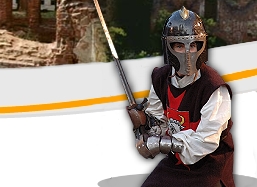|
Labiau Castle in Polessk (Polessk District)
The earliest mention of Labiau dates back to 1258. At that
time Labiau was most probably an old Baltic Prussian village
or a small fortified settlement. The name may have derived
from the Prussian name of the Dejma River, the Laba, or perhaps
the root of the name 'labs' meant 'nice' or 'good' in the
Prussian language. Under the German influence, the name was
changed into Labiau.
Originally the village was inhabited by farmers, fishermen
and craftsmen, who used to pray to their pagan gods, make
fishing nets, build boats to catch fish, graze cattle and
farm the land.
The first timber fortress was built by the
Teutonic Knights during the second Prussian surge, around
the year 1274 (other sources suggest that the first stronghold
was established in 1258). It stood at the mouth of the Laba
River and protected this waterway. During the Prussian uprisings,
the fortress changed hands, being alternately demolished and
then reconstructed. Finally, in the late 1380s the Teutonic
Knights returned to Labiau, this time to stay. The earth and
timber construction was subsequently replaced by then modern
fortifications.
In 1347 and in 1352, Labiau attacked by Lithuanians.
While the lands around the castle were ravaged by troops of
horse-mounted warriors led by the Dukes Algirdas and Kęstutis,
the local people escaped to Labiau and hid behind the fortified
walls of the fortress, but the Lithuanians made no decision
to besiege the town. In 1352 the Teutonic Knights waged an
unsuccessful attack on Lithuania. Upon their return to Labiau,
they decided to reinforce the fortress. New entrenchments
were made and the old walls were repaired. A few years later,
in 1360, construction of a new stone and brick fortress began.
The new castle was raised on a small isle surrounded by a
crescent-shaped moat, deep enough to let ships enter, which
is why a new harbour was built near the castle. The earth
from the moats and old entrenchments was used to strengthen
the castle hill. The new castle in Labiau was nicknamed 'a
castle on water'. The building was laid on an irregular quadrilateral
plan with all the castle wings being the same height. The
foundations and walls up to 4-5 meters height were built from
boulders; above - they were brick walls.
The ground floor had household functions, containing a kitchen
and a bakery, for instance. The west wing was residential.
It also had a huge furnace and a heating system fitted in.
In the north wing there was a gatehouse. In the east wing
there was a sanitary tower, known as 'dansker'. The walls
were between 2 and 3 meters thick. There were most probably
two watchtowers - in the eastern and western corners. Inside
the castle, around the inner ward there was an arcaded walk,
which took to the first floor. And there, on the first floor,
we can still see some halls with cross and rib vaults. In
the middle of the inner court, the building master Hannus
Bolle of Gdansk made a deep well.
Around the castle there was an outer ward, encircled with
a ring of fortified walls. One of the towers which belonged
to these fortifications has survived to the present day, albeit
extensively redesigned. There was also a church in the castle
compound, called St George's Church. It was first mentioned
in written records in 1408, but in 1541 it was converted into
a brewery and finally demolished in 1880.
In the 16th century the castle was completely
reconstructed to serve as a residence for the Duchess of Prussia.
Some of the halls were decorated with frescoes executed by
the Italian artist Gianbattista, also called Johann von Braun.
A century later the castle began to lose its status. Some
of the fortifications, then useless, were demolished and the
buildings often stood empty. In 1818, when Labiau became the
capital town of the district, the old castle was redesigned
again. The old vaults were destroyed and new windows were
made in the old walls.
The building was now housed the local authorities,
a court of law and a prison. Although World War Two left 'the
castle on water' in very bad state of repair, the prison was
not closed down until 1964, when the castle was completely
abandoned. Soon it was extensively devastated. For a few years
it was occupied by a factory. In 1990 the ruined castle was
ceded to the local government of Polessk, which intended to
use it for cultural purposes.
Today those few castle chambers that have preserved the original
vaults house a modest museum. Some other rooms contain an
amateur theatre and several commercial companies. Most of
the castle stands empty and desolate.
|






![]()
![]() On
the trail of the castles in the Baltic Sea region - revitalization and promotion
of the objects
On
the trail of the castles in the Baltic Sea region - revitalization and promotion
of the objects